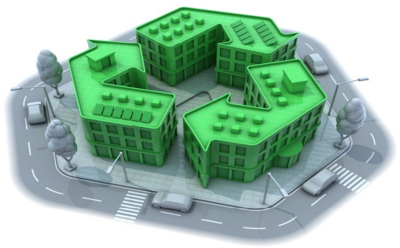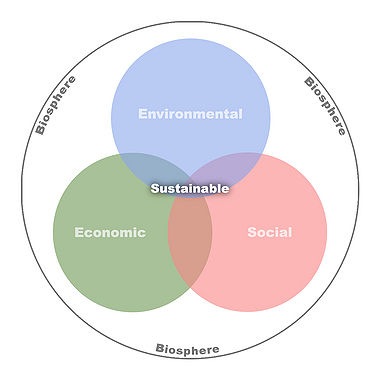Sustainability in construction
(→Environmental) |
|||
| Line 55: | Line 55: | ||
[[File:faser.png|thumb|500px|Figure 3: | [[File:faser.png|thumb|500px|Figure 3: | ||
Life Cycle Assessment <ref> http://bygningsreglementet.dk/file/554542/baeredygtigt_byggeri.pdf </ref> ]] <br> | Life Cycle Assessment <ref> http://bygningsreglementet.dk/file/554542/baeredygtigt_byggeri.pdf </ref> ]] <br> | ||
| + | |||
| + | {| class="wikitable" | ||
| + | |+ Life cycle of the building | ||
| + | ! [[Life cycle phases]] | ||
| + | ! [[Explanation]] | ||
| + | |||
| + | |- | ||
| + | ! Production | ||
| + | | This phase concerns the processes associated with the production of the construction products which is used in the building: Extraction of raw materials, transport to production site and the final production of construction products. | ||
| + | |- | ||
| + | ! Construction process | ||
| + | | This phase covers the processes that is related to the construction products' path from production until the time of installation as part of the construction: Transport from manufacturer to construction site and installation in construction. | ||
| + | |- | ||
| + | ! Use | ||
| + | |This phase concerns the processes related to the continued performance of the construction products as part of the building, i.e. maintenance, replacement, repair, etc. In addition, processes relating to the continuous consumption of water and energy for the operation of the building. The processes will often rely on scenarios, which is, conceptions of how the processes will take place. | ||
| + | |- | ||
| + | ! End of service | ||
| + | |The processes in this phase are also scenario-based. These scenarios deal with what happens when the building is worn, i.e. the demolition of the building and the subsequent processes for reprocessing or treatment of building materials until disposal or further use in other product systems. | ||
| + | |- | ||
| + | ! Next production system | ||
| + | |This scenario-based phase contains the calculated gains and disadvantages of recycling and recycling of building materials. Contributions from this phase shall, according to the European standards be considered outside the boundaries of the system and reported separately. | ||
| + | |||
| + | |} | ||
<br><br><br><br><br><br><br><br><br><br><br><br><br><br> | <br><br><br><br><br><br><br><br><br><br><br><br><br><br> | ||
Revision as of 17:41, 10 June 2017
Construction is accountable for a great part of the world’s total energy and resource consumption. It is therefore highly crucial that practitioners ensure a sustainable development of construction in order to address the current global climate and environmental challenges. This requires both an environmental, social and economic point of view to obtain an ambitious effort around sustainability in construction. The quality of our buildings and the construction environment are important for society in a broad perspective and crucial to people's social activities and well-being. Buildings often have a lifespan that surpasses all other products surrounding us and therefore the consequences of the choices one makes today have long term implications.
Sustainability in construction consists as mentioned of environmental, social and economic dimensions. These three dimensions needs to be weighted balanced from a life-cycle perspective and thought through in every aspect of the construction process. Together these dimensions characterize sustainability in construction and covers a variety of conditions which must be included in the planning of sustainable constructions. This means, that the planning of buildings must be considered from a broad and long term perspective. Further, the sustainability effort must be addressed throughout the entire value chain and the implications should be beneficial for all involving parties.
Contents |
A holistic concept
The Brundtland report was the first to focus on global sustainability and launched a comprehensive approach to sustainability that included social, economic and environmental aspects. The report concluded that environmental problems are increasingly global and cross-border. They therefore require international solutions and wide cooperation between all actors. The main objective of the Brundtland Commission was to show the way to future development:
“(…) Development that meets the needs of the present without compromising the ability of future generations to meet their own needs" [1]
A holistic concept of sustainability involves a reconciliation of environmental, social and economic dimensions. Thus, the concept of sustainability excludes the option of focusing only on for example, economics, as the main idea is to think as a trinity. Companies have also begun to focus on managing construction as a trinity where they include the social and environmental in their economic bottom line. Thus, in addition to having a good profit performance, they must also be socially responsible and take the environment into account. The triple bottomline was hereby introduced by John Elkington in 1994 [2], where economic, environmental and social goals were aligned and the impact on the decisions and actions of the organization.
The concept of sustainability is distinguished by taking care of the interaction between different processes and recognizing that the world consists of mutual dependencies. In practice, however, there will be subject areas that have a heavier weighting of either economic, environmental or social.
Think long term and wide
Throughout the construction value chain, it is necessary to work based on some ambitious and long-term visions. Only in this way it is possible to speed up the development and achieve the necessary conversion of the construction sector. Sustainability work can be summarized in two basic paradigms that can give a superior understanding of the concept and used as a common vision in specific projects. Sustainability in construction must be ensured by:
Think long term - Life cycle perspective
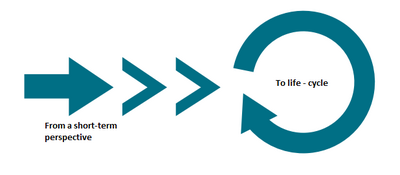
The life cycle perspective is an essential part of the understanding of sustainability in construction. Buildings often have a lifespan that surpasses all other products surrounding us and therefore the consequences of the choices one makes today have long term implications. The environmental quality in the life cycle perspective consider the environmental impacts and resource consumption throughout the lifespan of the building - from construction to operation, demolition and recycling. The social dimension ensures the framework for health and well-being for all those who are affected by the construction. The economic quality deals with the considerations of the economic conditions associated with construction, operation and maintenance throughout the building life expectancy. As well it needs to consider the potential of the building to maintain its economic value despite changes in the utility of the building and societal changes.
Think wide - Holistic perspective
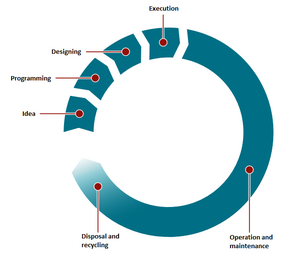
The vision of sustainability is creating quality in all parts of the building, both in the actual construction where an appropriate balance must be ensured for environmental, social and economic considerations, and how the coherence between the city and society in which the building is a part of. In pursuit of sustainable solutions, there are many examples on choices and solutions that can a first emerge sustainable but not in a holistic perspective for sustainable solutions. For example, a unilateral focus on energy savings without regard to the indoor climate result in imbalance between the environmental and the social quality, and thus result in a poor holistic sustainable solution. Another example could be an attempt to minimize transport expenses by having a requirement to use locally produced materials without looking at the energy used to produce the local materials.
There has been a tendency for sustainability in construction to measure the magnitude of sustainability only from a unilateral point of view. However, sustainability in construction implies planning and decision making from a holistic perspective, which cannot be ensured by individual measures. The decision making and planning should at all time be aimed at the construction as a sustainable unit which helps to solve the environmental and societal confrontations and challenges that are being face.
The three dimensions in sustainability
Environmental
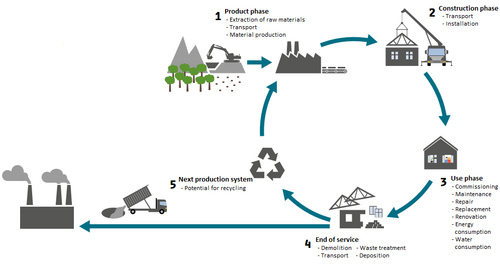
| Life cycle phases | Explanation |
|---|---|
| Production | This phase concerns the processes associated with the production of the construction products which is used in the building: Extraction of raw materials, transport to production site and the final production of construction products. |
| Construction process | This phase covers the processes that is related to the construction products' path from production until the time of installation as part of the construction: Transport from manufacturer to construction site and installation in construction. |
| Use | This phase concerns the processes related to the continued performance of the construction products as part of the building, i.e. maintenance, replacement, repair, etc. In addition, processes relating to the continuous consumption of water and energy for the operation of the building. The processes will often rely on scenarios, which is, conceptions of how the processes will take place. |
| End of service | The processes in this phase are also scenario-based. These scenarios deal with what happens when the building is worn, i.e. the demolition of the building and the subsequent processes for reprocessing or treatment of building materials until disposal or further use in other product systems. |
| Next production system | This scenario-based phase contains the calculated gains and disadvantages of recycling and recycling of building materials. Contributions from this phase shall, according to the European standards be considered outside the boundaries of the system and reported separately. |
Social
Economic
Limitations
Annotated Bibliography
References
- ↑ http://www.un-documents.net/our-common-future.pdf
- ↑ http://www.johnelkington.com/archive/TBL-elkington-chapter.pdf
- ↑ http://bygningsreglementet.dk/file/554542/baeredygtigt_byggeri.pdf
- ↑ http://bygningsreglementet.dk/file/554542/baeredygtigt_byggeri.pdf
- ↑ http://bygningsreglementet.dk/file/554542/baeredygtigt_byggeri.pdf
